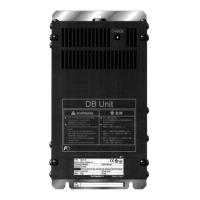9.1 Overview of RS-485 Communication
9-8
9.1.4 RS-485 connection devices
This section describes the devices required for connecting the inverter to a PC having no RS-485 interface or for
connecting two or more inverters in multi-drop network.
[ 1 ] Converter
In general, PC is not equipped with an RS-485 port. Therefore, an RS-232C–RS-485 or USB–RS-485 converter is
required. To use the equipment properly, be sure to use the converter which meets the mode below. Be careful that
a converter not recommended may not work properly.
Requirements for recommended converters
Send/receive switching system:
Auto-switching by monitoring the transmission data at PC (RS-232C)
Electrically isolated from the RS-485 port
Note: The fail-safe function refers to a feature that ensures the RS-485 receiver’s output is at “logic high” even if
the RS-485 receiver’s input is opened or short-circuited or all the RS-485 drivers are inactive. (Refer to
“Figure 9.1-4 Communication Level Conversion”.)
Recommended converters
System Sacom Sales Corporation (Japan) : KS-485PTI (RS-232C-RS-485 converter)
: USB-485I RJ45-T4P (USB-RS-485 converter)
Send/receive switching system
The RS-485 communication system of the inverter acts in half-duplex mode (2-wire), so the converter must have a
send/receive switching function. Generally, the switching system may be either one of the followings.
(1) Auto-switching by monitoring the transmitted data
(2) Switching by RS-232C control signal (RTS or DTR) from the computer
Figure 9.1-4 Communication Level Conversion
FRENIC-Ace (two-wire system)

